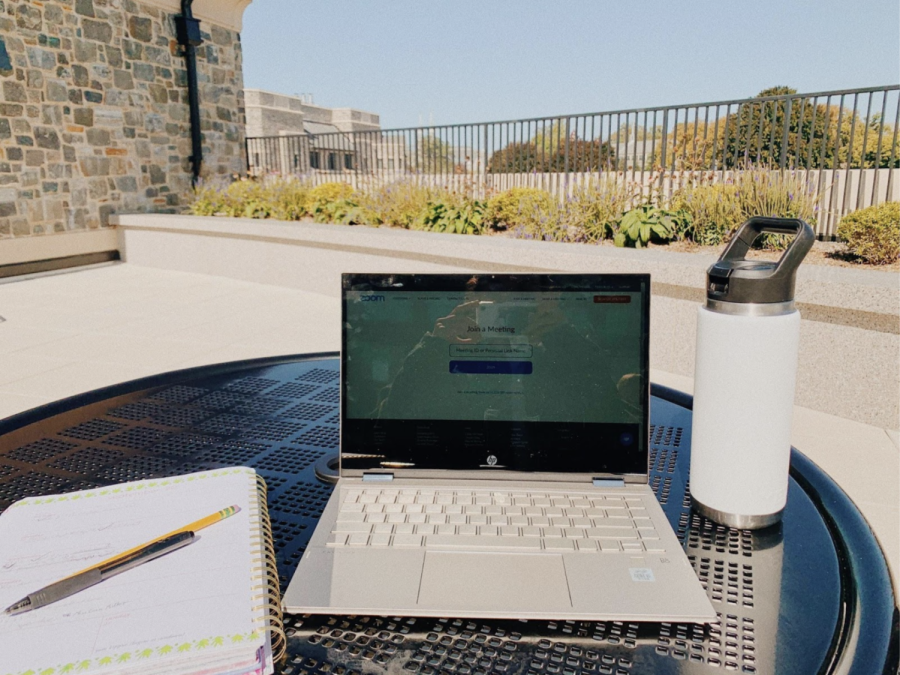Zoom Fatigue Beginning to Affect University Students
Students choose to take classes oustide, especially at the Center for the Performing Arts.
September 30, 2020
The online platform Zoom has become an omnipresent channel of communication as a result of the COVID-19 pandemic. The platform has been an essential tool in perpetuating the country’s businesses, schools and more. However, the effects of constant online interfacing have impacted the well-being of many Zoom participants. Coining it “Zoom fatigue,” participants who spend hours on video chats have encountered issues.
Zoom fatigue can be described as the mental and physical exhaustion one faces from video-chatting for extended periods, and this reaction has multiple causes. According to BBC, Zoom has a negative connotation to the subconscious, as it is a reminder of the state of the world and how that has affected everyday life. Zoom also provides an unnatural learning experience. Projecting an image of the users back to them, it causes a hyper-awareness of how users are being perceived.
As for the atmosphere Zoom creates, “Our minds are together when our bodies feel we’re not,” Gianpiero Petriglieri, a professor at Instead, said in an article for the BBC. “That dissonance…is exhausting. You cannot relax into the conversation naturally.”
Zoom’s popularity makes it the point of contact for every class, club, church service and more, but the sudden lack of variety in the places of activity taxes the brain. This taxation relates to what is known as “Self-Complexity Theory,” which concludes that the brain thrives off of having different categories for different social situations. The less variation, the easier it is to be plagued with cognitive negativity, according to the BBC.
Harvard Business Review relates Zoom fatigue to how humans stay attuned to conversation. The Review reports, “On a video call the only way to show we’re paying attention is to look at the camera. But, in real life, how often do you stand within three feet of a colleague and stare at their face? Probably never.”
Constant staring through Zoom exhausts the human mind. The brain is forced to keep both constant attention to the screen interface, as well as to the appearance of what the preconceived ideas of attention looks like. People have to work twice as hard to read social cues, stay attentive and keep their eyes directed to their screen, all while distractions like roommates, text messages and other externalities swarm the environment.
University students have also experienced Zoom fatigue. A handful of students, ranging from ages of 18 to 21, were asked a number of questions about their semesters thus far in regard to the new learning format. Several students had only a few online classes, whereas others had the majority or all of their classes online.
When asked if they had experienced Zoom fatigue, all responded with the affirmative. They were then asked how online learning had been for them personally, if it had been hard or easy and if they could report any positive and/or negative effects. The most prominent commonality amongst the responses in regard to the negative effects of Zoom was the struggle to pay attention for long periods of time to a computer screen.
“It is hard to pay attention, be organized and not be distracted while on Zoom,” sophomore Nursing major Kelly Bratton said.
Sophomore VSB student Alice Ke noted that “discussion-based classes are very awkward, I try to participate as much as I can, but as one student I can only say so much.”
Despite these troubling effects, students have found the positives in online classes. Those interviewed talked about the ease of being able to roll out of bed for class without running from building to building, and upperclassmen relayed positive sentiments about the convenience of doing class from their off-campus homes.
As Zoom continues to be the main source of communication for these trying times, University students have found ways of preventing Zoom fatigue. In attempting to combat online induced exhaustion, a few of the interviewees invested in blue light glasses to help with the eye strain, caused by long hours at a computer. Almost all respondents mentioned getting outside, taking breaks and limiting computer time when possible. Another highly recommended practice was to vary where online classes are taken. A few students highlighted the avoidance of taking class in one’s dorm, recommending different buildings around campus to give more diversity to one’s schedule and in turn helping with class engagement.
As COVID-19 continues to affect the way students learn, it is important to note how Zoom can affect its users. However, through interviewing just a handful of students on and off campus, it is clear that they bear a resilience aided by both the desire to learn and the love for the University.
In regard to Zoom fatigue, senior Civil Engineer major Marlee Newman noted that it is important to keep “engaging with professors and asking more questions, because I feel like they get Zoom fatigue too.”
Focusing on the well-being of others, Newman’s response exemplifies what it means to be a Villanova student during this time. Newman brings up the pinnacle combatant to Zoom fatigue, one that has been prominent in the actions of University students throughout the pandemic. With every wave of Zoom fatigue comes an even stronger University community, ready to combat the struggles together, to help one another and to further the Villanova mission.



